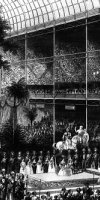|
"Its grandeur does not consist in one thing, but
in the unique assemblage of all things. Whatever human industry
has created you find here."
Charlotte Brontė, Letter of 1851
Britain's role in the world was also celebrated
in the Great Exhibitions of the Works of All Nations staged in Joseph
Paxton's Crystal Palace in Hyde Park 1851. Exhibits were requested
from all over the world including natural wonders including the
Koh-I-Noor diamond, machinery, manufactures, crafts and fine arts.
In all over 100,000 exhibits were provided by 13,937 exhibitors.
7,381 from the United Kindgom and its dependencies and 6,556 from
the rest of the world.
Exhibits from the former were grouped westward of
the central trancept while those of other nations were placed together
eastward. The position of each countries display was determined
by its latitude. Mediterranean and tropical states nearer the trancept
than temperate nations. In all about 2 million people visited the
exhibition from the 1ST May, when it was formally opened by Queen
Victoria, and 15th October, most paying several visits. In an attempt
to attract all social classes entrance fees were varied. On two
days when admission cost £1 only a few wealth visitors came. On
the 80 days when the entrance charge was a shilling nearly 4.5million
tickets were sold.
The Great Exhbition of 1851 was followed by the
1862 exhibition in South Kensington and from that point on there
were a whole series of similar Exhibitions throughout London and
the rest of the UK. The forty years running up to the First World
War were the golden age for exhibitions of this type throughout
the world. The later exhibitions were even more epic in scale, and
with a change of emphasis from education to entertainment were hugely
popular with the public.
In the early exhibitions the objects were displayed,
people explained and worked them, and people thronged to listen.
These were massive unprecedented displays, in buildings specifically
designed to take your breath away with their size and opulence.
Later exhibitions became themed with whole events given over to
the produce of one nation only including the American Exhibition
(at Earl's Court 1887, the Italian Exhibition (at Earl's Court in
1888) and the Greater Britain Exhibition at Earl's Court Olympia
1899.
The semi-permanent facilities built for the exhibitions
in South Kensington were used a number of times in immediately succeeding
years and this led to plans for the permanent museums on the site
to be brought to fruition. The Earl's Court Exhibition complex was
built in 1887, used for a number of exhibitions and evolved into
the permanent show centre it is today.
further reading
Greenhalgh, Paul Education, Entertainment
and Politics: Lessons from the Great International Exhibitions in
The New Museology, Ed Peter Vergo, Reaktion Books, London 1989
|


